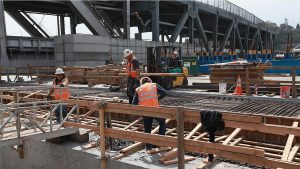The Cybertruck, Tesla’s all-new electric pickup truck, is here, looking like a triangle from the future, and it can take a sledgehammer to the door with nary a dent. And while that might not be a day-to-day use case for many prospective buyers, it’s very handy if you’re showing off the prowess of your latest all-electric model for the first time at a glitzy event in Los Angeles, as Tesla (and SpaceX) CEO Elon Musk did Thursday night. And just for fun, Musk showed off another new Tesla product: an (obviously) electric ATV. Truck production, according to Tesla’s website, is slated for late 2021.
The base version of the Cybertruck, with a single motor, will start at $39,900, good for 250 miles of range, a tow rating of 7,500 pounds, and a 0 to 60 mph time of 6.5 seconds. A dual motor $49,000 version can tow 10,000 pounds and reach 60 mph in 4.5 seconds, with 300 miles of range. And the top of the line variant, starting at $69,900, will go more than 500 miles between charges, hit 60 mph in under 60 seconds, tow up to 14,000 pounds, and start production in late 2022. That one, per a slide Musk showed, has a tri-motor setup, though the CEO didn’t explain how that would work. (Single motor setups tend to put the motor on the rear axle, dual motor setups put one motor on each axle.)
Want the latest Tesla news in your inbox? Sign up here!
In his unusually short, 25-minute presentation, Musk didn’t say when the truck will head into production. But he did speak to the importance of entering the pickup segment, one of the most popular in the US. “We need something different. We need sustainable energy now,” Musk said on stage, before a crowd of fans and journalists at SpaceX’s headquarters.
As with its other models, Tesla gave Cybertruck some thoughtful goodies. It has 120-volt and 240-volt power outlets and an onboard air compressor, turning the truck into a mobile power station for worksites. According to previous Twitter reveals from Musk, it can parallel park itself (now a common feature in new cars) should it ever wander into a city. And, for unclear reasons, it’s bulletproof, at least to a 9-millimeter handgun. Though when Musk invited Tesla designer Franz von Holzhausen to throw a metal ball at the window, the result was major cracking, and a somewhat embarrassed CEO.
Putting aside a less than ideal performance onstage, the Cybertruck represents a potentially big part of Tesla’s future, as the automaker seeks to expand its footprint and improve its financials. Pickup trucks make up roughly 15 percent of US vehicle sales, a share that has steadily grown since 2009, according to research shop IHS Markit. The Ford F-150 has been the top-selling passenger vehicle in the US for 36 years straight; Americans buy nearly a million every year. More important, pickups produce serious profits: Reuters has reported that General Motors nets, on average, $17,000 per pickup. On high-end models with the sorts of options that push sale prices above $100,000, that margin can reach $50,000. And while Tesla will have serious competition here, the pickup battlefield is mostly limited to domestic manufacturers, thanks to Lyndon Johnson’s “chicken tax” that puts a 25 percent tariff on imported light trucks.
Since it started building the lowish-cost Model 3 by the tens of thousands, hitting its stride in the back half of 2018, Tesla has relied on volume to periodically break into the black, sending Musk on a long, painful slog through “production hell.” A vehicle line that delivers more money per vehicle could ease that pressure. As with luxury sedans and SUVs, IHS Markit analyst Stephanie Brinley says, “people will pay more for more space and more capability.”
That capability will be key to the Cybertruck’s success. Unlike luxury SUVs with off-roading abilities nobody really uses, pickups are commonly put to work. Many go to contractors, construction workers, and the like—folks who need their beds and capacious torque to get a job done. Others go to civilians who spend their weekends dirt biking, or riding horses, or taking the boat to the lake, and need a pickup’s power to schlep their equipment around. “You can’t swap in a Camry for an F-150,” Brinley says.
The good news for Tesla is that pickups can make good electric vehicles, and vice versa. The large, expensive vehicles accommodate large, expensive batteries better than a compact sedan does. The torque that flows so easily from electric motors and allows for Tesla’s “ludicrous” acceleration is also what gives the Cybertruck its strength. Owners who drive set routes between work sites might be able to plan their charging stops. Pickup customers are less likely to live in an apartment building than a single-family house where they can install a home charger. On the other hand, public charging infrastructure is hardly developed in the middle of the country where pickups are especially popular. As an example, Chargepoint, the nation’s largest EV charging provider, has more than 500 stations in San Francisco, and fewer than 150 in North and South Dakota, combined. Tesla has just eight supercharger stations in South Dakota, and none in its northern neighbor.
Pickup trucks make up roughly 15 percent of US vehicle sales, and Elon Musk hopes the Cybertruck will be Tesla’s tool for wedging itself into that market.
Courtesy of TeslaNo wonder, then, that Tesla isn’t the only automaker moving into this space. All-electric newcomer Rivian plans to start building its $69,000 R1T truck next year. Another startup, Bollinger, is developing a limited-volume, trail-bashing electric pickup. Ford is planning to build a battery-powered F-150 in the next few years; in July it had a prototype version haul a 1.3 million-pound train around a Canadian railyard. GM announced just Thursday afternoon that its previously announced electric pickup will enter production in the fall of 2021. Those electric vehicles, though, won’t be the Cybertruck’s real competition. Pickup buyers, according to research by Cox Automotive, hardly consider fuel economy when shopping. They care about capability and reliability. Plus, compared with other drivers, they’re particularly loyal to their brands of choice.
For the Cybertruck to succeed the way the Model 3 has, Tesla must steal the customers Ford, GM, Chrysler, and other automakers most value. To paraphrase Boromir, one does not simply walk into Detroit with such a plan. The big automakers pay very careful attention to their trucks: They know their customers well, and develop each new model based on decades of learnings. Musk has a knack for rethinking the customer experience, and the Cybertruck’s radical design could appeal to drivers looking for something different. But when it comes to meeting what those drivers really need and want from their trucks, it’s playing catch up. “Tesla can figure it out, but they don’t already know,” Brinley says. “If the truck can’t deliver the functionality [drivers] need, they’re not gonna buy it.” Which means that Tesla is fixing to challenge its core competency—designing vehicles that delight and surprise their drivers—as never before.
Moreover, Tesla has struggled with reliability. In February, Consumer Reports revoked its recommended status for the Model 3, citing problems like stuck latches and malfunctioning doors. (As Tesla smoothed out Model 3 production, it settled those issues, and Consumer Reports restored its recommendation last week.) The Model X SUV, in particular, has been plagued with problems, many stemming from its overly complex falcon wing doors.
Such troubles would inconvenience any driver, but they could cause serious problems for one who relies on the Cybertruck not just to get to their job, but to do it. And those jobs often entail repeated towing, offroading, and other labors that “border on abuse,” says Brian Moody, the executive editor of Autotrader. If Tesla’s pickup can’t keep up, customers “are going to be very vocal about their dissatisfaction.”
All that, though, only matters if Tesla can actually turn the prototype Musk debuted onstage into an actual product. The Roadster, Model S, Model X, and Model 3 also hit the market well after Musk’s targets. Once they did, they came off the line slowly, and with problems. The learning curve has been steep. And before Tesla starts making the Cybertruck, it has to get the Model Y, the baby SUV Musk showed off in March, into production. The Silicon Valley upstart is also working to roll out its semi truck and revamped Roadster sports car sometime next year. It’s not clear how Tesla might incorporate another new kind of vehicle into facilities already building an increasingly complex model lineup.
So the Cybertruck will be a few years in the making. And if you’re eager to use it to do your job, better hope Musk and Tesla can do theirs.
More Great WIRED Stories
- The strange life and mysterious death of a virtuoso coder
- Wish List 2019: 52 amazing gifts you’ll want to keep for yourself
- How the climate crisis is killing us, in 9 alarming charts
- Why my friend became a grocery store on Instagram
- How to lock down your health and fitness data
- 👁 A safer way to protect your data; plus, the latest news on AI
- 🏃🏽♀️ Want the best tools to get healthy? Check out our Gear team’s picks for the best fitness trackers, running gear (including shoes and socks), and best headphones.



